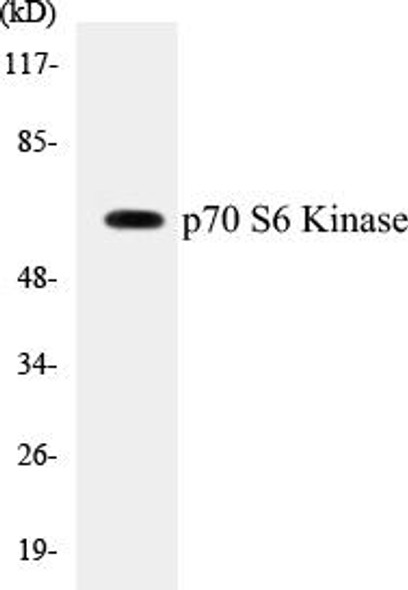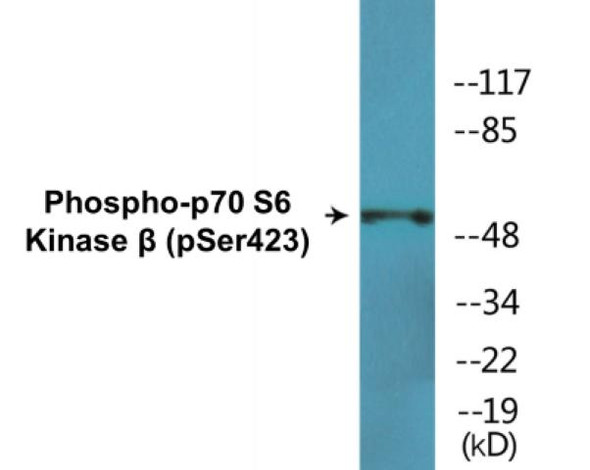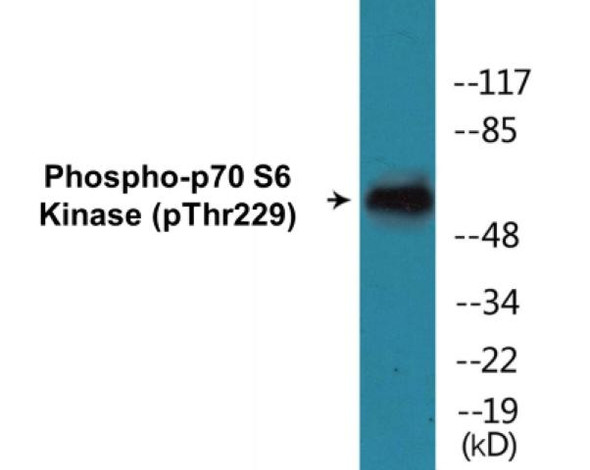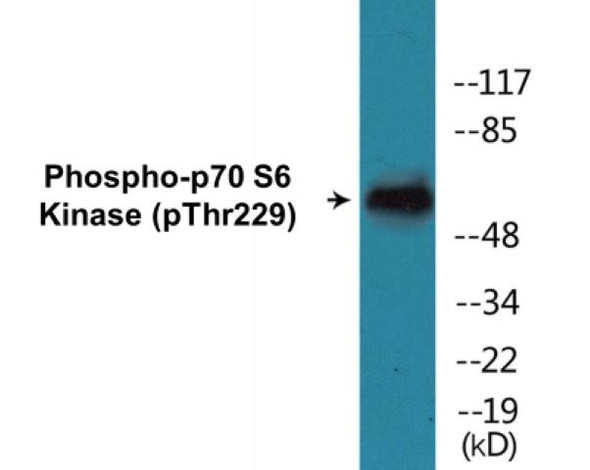p70 S6 Kinase beta Colorimetric Cell-Based ELISA Kit
- SKU:
- CBCAB00796
- Product Type:
- ELISA Kit
- ELISA Type:
- Cell Based
- Reactivity:
- Human
- Mouse
- Detection Method:
- Colorimetric
Description
p70 S6 Kinase beta Colorimetric Cell-Based ELISA Kit
The p70 S6 Kinase Beta Colorimetric Cell-Based ELISA Kit is a highly sensitive and specific assay designed for the accurate detection of p70 S6 Kinase Beta levels in cell lysates. This kit provides reliable and reproducible results, making it ideal for a variety of research applications.p70 S6 Kinase Beta is a key signaling protein that plays a crucial role in cell growth, proliferation, and survival. Dysregulation of p70 S6 Kinase Beta has been implicated in various diseases including cancer, metabolic disorders, and neurological conditions, making it an important biomarker for studying these diseases and potential therapeutic targets.
With its ease of use and high performance, the p70 S6 Kinase Beta Colorimetric Cell-Based ELISA Kit is a valuable tool for researchers studying the role of p70 S6 Kinase Beta in cellular signaling pathways and disease mechanisms.
| Product Name: | p70 S6 Kinase beta Colorimetric Cell-Based ELISA |
| Product Code: | CBCAB00796 |
| ELISA Type: | Cell-Based |
| Target: | p70 S6 Kinase beta |
| Reactivity: | Human, Mouse |
| Dynamic Range: | > 5000 Cells |
| Detection Method: | Colorimetric 450 nmStorage/Stability:4°C/6 Months |
| Format: | 96-Well Microplate |
The p70 S6 Kinase beta Colorimetric Cell-Based ELISA Kit is a convenient, lysate-free, high throughput and sensitive assay kit that can detect p70 S6 Kinase beta protein expression profile in cells. The kit can be used for measuring the relative amounts of p70 S6 Kinase beta in cultured cells as well as screening for the effects that various treatments, inhibitors (ie siRNA or chemicals), or activators have on p70 S6 Kinase beta.
Qualitative determination of p70 S6 Kinase beta concentration is achieved by an indirect ELISA format. In essence, p70 S6 Kinase beta is captured by p70 S6 Kinase beta-specific primary antibodies while the HRP-conjugated secondary antibodies bind the Fc region of the primary antibody. Through this binding, the HRP enzyme conjugated to the secondary antibody can catalyze a colorimetric reaction upon substrate addition. Due to the qualitative nature of the Cell-Based ELISA, multiple normalization methods are needed:
| 1. | A monoclonal antibody specific for human GAPDH is included to serve as an internal positive control in normalizing the target absorbance values. |
| 2. | Following the colorimetric measurement of HRP activity via substrate addition, the Crystal Violet whole-cell staining method may be used to determine cell density. After staining, the results can be analysed by normalizing the absorbance values to cell amounts, by which the plating difference can be adjusted. |
| Database Information: | Gene ID: 6199, UniProt ID: Q9UBS0, OMIM: 608939, Unigene: Hs.534345 |
| Gene Symbol: | RPS6KB2 |
| Sub Type: | None |
| UniProt Protein Function: | P70S6KB: an AGC kinase of the RSK family that is required for cell growth and G1 cell cycle progression. Is phosphorylated and activated by mTOR in mitogenic pathways downstream of phosphoinositide 3 kinase (PI3K). Phosphorylates the S6 protein of the 40S ribosomal subunit and is involved in translational control of 5' oligopyrimidine tract mRNAs. Activity is controlled by multiple phosphorylation events located within the catalytic, linker and pseudosubstrate domains. Mouse knockout shows symptoms of insulin resistance, and increased insulin senstivity, resulting in protection against diet-induced obesity. Protein expression and activation upregulated in colon adenocarcinoma cell lines. Increased expression in breast cancer correlated with poor survival. Selectively amplified and overexpressed within the 17q23 breast cancer amplicon. Two isoforms produced by alternative initiation have been reported. |
| UniProt Protein Details: | Protein type:EC 2.7.11.1; Protein kinase, AGC; Translation; Protein kinase, Ser/Thr (non-receptor); Kinase, protein; AGC group; RSK family; p70 subfamily Chromosomal Location of Human Ortholog: 11q13.2 Cellular Component: cytoplasm; nucleoplasm Molecular Function:ATP binding; peptide binding; protein kinase activity; protein serine/threonine kinase activity; ribosomal protein S6 kinase activity Biological Process: epidermal growth factor receptor signaling pathway; fibroblast growth factor receptor signaling pathway; innate immune response; nerve growth factor receptor signaling pathway; phosphoinositide-mediated signaling; positive regulation of translational initiation; protein amino acid phosphorylation; protein kinase B signaling cascade; signal transduction; translation |
| NCBI Summary: | This gene encodes a member of the RSK (ribosomal S6 kinase) family of serine/threonine kinases. This kinase contains a kinase catalytic domain and phosphorylates the S6 ribosomal protein and eukaryotic translation initiation factor 4B (eIF4B). Phosphorylation of S6 leads to an increase in protein synthesis and cell proliferation. [provided by RefSeq, Jan 2015] |
| UniProt Code: | Q9UBS0 |
| NCBI GenInfo Identifier: | 296434560 |
| NCBI Gene ID: | 6199 |
| NCBI Accession: | Q9UBS0.2 |
| UniProt Secondary Accession: | Q9UBS0,O94809, Q9UEC1, B2RMZ9, B4DML8, |
| UniProt Related Accession: | Q9UBS0 |
| Molecular Weight: | 16,868 Da |
| NCBI Full Name: | Ribosomal protein S6 kinase beta-2 |
| NCBI Synonym Full Names: | ribosomal protein S6 kinase B2 |
| NCBI Official Symbol: | RPS6KB2 |
| NCBI Official Synonym Symbols: | KLS; SRK; S6K2; STK14B; p70S6Kb; P70-beta; S6K-beta2; P70-beta-1; P70-beta-2; p70(S6K)-beta |
| NCBI Protein Information: | ribosomal protein S6 kinase beta-2 |
| UniProt Protein Name: | Ribosomal protein S6 kinase beta-2 |
| UniProt Synonym Protein Names: | 70 kDa ribosomal protein S6 kinase 2; P70S6K2; p70-S6K 2; S6 kinase-related kinase; SRK; Serine/threonine-protein kinase 14B; p70 ribosomal S6 kinase beta; S6K-beta; p70 S6 kinase beta; p70 S6K-beta; p70 S6KB; p70-beta |
| Protein Family: | Ribosomal protein S6 kinase |
| UniProt Gene Name: | RPS6KB2 |
| UniProt Entry Name: | KS6B2_HUMAN |
| Component | Quantity |
| 96-Well Cell Culture Clear-Bottom Microplate | 2 plates |
| 10X TBS | 24 mL |
| Quenching Buffer | 24 mL |
| Blocking Buffer | 50 mL |
| 15X Wash Buffer | 50 mL |
| Primary Antibody Diluent | 12 mL |
| 100x Anti-Phospho Target Antibody | 60 µL |
| 100x Anti-Target Antibody | 60 µL |
| Anti-GAPDH Antibody | 60 µL |
| HRP-Conjugated Anti-Rabbit IgG Antibody | 12 mL |
| HRP-Conjugated Anti-Mouse IgG Antibody | 12 mL |
| SDS Solution | 12 mL |
| Stop Solution | 24 mL |
| Ready-to-Use Substrate | 12 mL |
| Crystal Violet Solution | 12 mL |
| Adhesive Plate Seals | 2 seals |
The following materials and/or equipment are NOT provided in this kit but are necessary to successfully conduct the experiment:
- Microplate reader able to measure absorbance at 450 nm and/or 595 nm for Crystal Violet Cell Staining (Optional)
- Micropipettes with capability of measuring volumes ranging from 1 µL to 1 ml
- 37% formaldehyde (Sigma Cat# F-8775) or formaldehyde from other sources
- Squirt bottle, manifold dispenser, multichannel pipette reservoir or automated microplate washer
- Graph paper or computer software capable of generating or displaying logarithmic functions
- Absorbent papers or vacuum aspirator
- Test tubes or microfuge tubes capable of storing ≥1 ml
- Poly-L-Lysine (Sigma Cat# P4832 for suspension cells)
- Orbital shaker (optional)
- Deionized or sterile water
*Note: Protocols are specific to each batch/lot. For the correct instructions please follow the protocol included in your kit.
| Step | Procedure |
| 1. | Seed 200 µL of 20,000 adherent cells in culture medium in each well of a 96-well plate. The plates included in the kit are sterile and treated for cell culture. For suspension cells and loosely attached cells, coat the plates with 100 µL of 10 µg/ml Poly-L-Lysine (not included) to each well of a 96-well plate for 30 minutes at 37°C prior to adding cells. |
| 2. | Incubate the cells for overnight at 37°C, 5% CO2. |
| 3. | Treat the cells as desired. |
| 4. | Remove the cell culture medium and rinse with 200 µL of 1x TBS, twice. |
| 5. | Fix the cells by incubating with 100 µL of Fixing Solution for 20 minutes at room temperature. The 4% formaldehyde is used for adherent cells and 8% formaldehyde is used for suspension cells and loosely attached cells. |
| 6. | Remove the Fixing Solution and wash the plate 3 times with 200 µL 1x Wash Buffer for five minutes each time with gentle shaking on the orbital shaker. The plate can be stored at 4°C for a week. |
| 7. | Add 100 µL of Quenching Buffer and incubate for 20 minutes at room temperature. |
| 8. | Wash the plate 3 times with 1x Wash Buffer for 5 minutes each time. |
| 9. | Add 200 µL of Blocking Buffer and incubate for 1 hour at room temperature. |
| 10. | Wash 3 times with 200 µL of 1x Wash Buffer for 5 minutes each time. |
| 11. | Add 50 µL of 1x primary antibodies (Anti-p70 S6 Kinase beta Antibody and/or Anti-GAPDH Antibody) to the corresponding wells, cover with Parafilm and incubate for 16 hours (overnight) at 4°C. If the target expression is known to be high, incubate for 2 hours at room temperature. |
| 12. | Wash 3 times with 200 µL of 1x Wash Buffer for 5 minutes each time. |
| 13. | Add 50 µL of 1x secondary antibodies (HRP-Conjugated AntiRabbit IgG Antibody or HRP-Conjugated Anti-Mouse IgG Antibody) to corresponding wells and incubate for 1.5 hours at room temperature. |
| 14. | Wash 3 times with 200 µL of 1x Wash Buffer for 5 minutes each time. |
| 15. | Add 50 µL of Ready-to-Use Substrate to each well and incubate for 30 minutes at room temperature in the dark. |
| 16. | Add 50 µL of Stop Solution to each well and read OD at 450 nm immediately using the microplate reader. |
(Additional Crystal Violet staining may be performed if desired – details of this may be found in the kit technical manual.)










